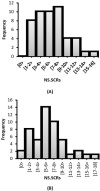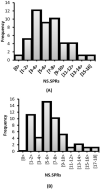Psychological Correlates of Nonspecific Electrodermal Responses
- PMID: 33584885
- PMCID: PMC7531214
- DOI: 10.2478/joeb-2019-0010
Psychological Correlates of Nonspecific Electrodermal Responses
Abstract
Spontaneous fluctuations in electrodermal responses are known as nonspecific electrodermal responses (NS.EDRs). The use of NS.EDRs as a tool in applied psychophysiological research has resulted in a variety of publications. NS.EDRs are examined separately as associated with the (as a biomarker of) levels of anxiety. The aim of this study was to compare changes (in terms of amplitude, frequency and time components) in NS.EDRs at two different (pre and post of an external stimulus) resting phases. NS.EDRs (nonspecific skin conductance responses (NS.SCRs), nonspecific skin potential responses (NS.SPRs), and nonspecific skin susceptance responses (NS.SSRs)) were recorded from 50 apparently healthy volunteers simultaneously at the same skin area. They were scored as NS.SCRs and NS.SSRs for changes greater than 0.02 μS and NS.SPRs greater than 0.02 mV. It was found that NS.EDRs, in particular NS.SCRs and NS.SPRs, were significantly changed in the second resting period, following the specific stimulus. More specifically, the amplitude of NS.EDRs were significantly decreased for NS.SCRs (p<0.001) and for NS.SPRs (p<0.005), but NS.SSRs remained stable. Moreover, the rise time of NS.SCRs was decreased in the second resting time. Furthermore, the frequency of responses was also changed. The computed NS.EDRs, in particular NS.SCRs and NS.SPRs could be of psychological interest and be used to study the electrodermal responses in detail. NS.SSRs were found to be robust with respect to nonspecific stimuli at various relaxation periods and their role was found to be less important in analysis of NS.EDRs in comparison to NS.SCRs and NS.SPRs at low frequency (20 Hz AC current). This should be considered in analysis of NS.EDRs. The computed NS.EDRs, especially NS.SCRs and NS.SPRs may be used as a useful measure of arousal due to their fast response and sensitivity to nonspecific stimuli and may also be used in assessment of individual differences.
Keywords: EDA; Electrodermal activity; nonspecific electrodermal responses; skin conductance responses; skin potential responses; specific electrodermal responses.
© 2019 Bari., published by Sciendo.
Conflict of interest statement
Conflict of interest Author states no conflict of interest.
Figures








Similar articles
-
Electrodermal responses to discrete stimuli measured by skin conductance, skin potential, and skin susceptance.Skin Res Technol. 2018 Feb;24(1):108-116. doi: 10.1111/srt.12397. Epub 2017 Aug 4. Skin Res Technol. 2018. PMID: 28776764
-
Electrodermal Activity Responses for Quantitative Assessment of Felt Pain.J Electr Bioimpedance. 2018 Dec 19;9(1):52-58. doi: 10.2478/joeb-2018-0010. eCollection 2018 Jan. J Electr Bioimpedance. 2018. PMID: 33584921 Free PMC article.
-
The Five Basic Human Senses Evoke Electrodermal Activity.Sensors (Basel). 2023 Sep 29;23(19):8181. doi: 10.3390/s23198181. Sensors (Basel). 2023. PMID: 37837011 Free PMC article.
-
Disturbances in Electrodermal Activity Recordings Due to Different Noises in the Environment.Sensors (Basel). 2024 Aug 22;24(16):5434. doi: 10.3390/s24165434. Sensors (Basel). 2024. PMID: 39205128 Free PMC article.
-
Power Spectral Density Analysis of Electrodermal Activity for Sympathetic Function Assessment.Ann Biomed Eng. 2016 Oct;44(10):3124-3135. doi: 10.1007/s10439-016-1606-6. Epub 2016 Apr 8. Ann Biomed Eng. 2016. PMID: 27059225
Cited by
-
Electrodermal lability and sensorimotor preparation: effects on reaction time, contingent negative variation, and heart rate.Cogn Affect Behav Neurosci. 2024 Dec;24(6):1155-1166. doi: 10.3758/s13415-024-01206-8. Epub 2024 Aug 14. Cogn Affect Behav Neurosci. 2024. PMID: 39143369 Free PMC article.
-
Electrodermal Activity Is Sensitive to Sleep Deprivation but Does Not Moderate the Effect of Total Sleep Deprivation on Affect.Front Behav Neurosci. 2022 Jul 4;16:885302. doi: 10.3389/fnbeh.2022.885302. eCollection 2022. Front Behav Neurosci. 2022. PMID: 35860724 Free PMC article.
-
A Circuit for Simultaneous Measurements of Skin Electrical Conductance, Susceptance, and Potential.J Electr Bioimpedance. 2019 Dec 31;10(1):110-112. doi: 10.2478/joeb-2019-0016. eCollection 2019 Jan. J Electr Bioimpedance. 2019. PMID: 33584891 Free PMC article.
-
Artificial intelligence tools for engagement prediction in neuromotor disorder patients during rehabilitation.J Neuroeng Rehabil. 2024 Dec 19;21(1):215. doi: 10.1186/s12984-024-01519-2. J Neuroeng Rehabil. 2024. PMID: 39702317 Free PMC article.
-
Task-state skin potential abnormalities can distinguish major depressive disorder and bipolar depression from healthy controls.Transl Psychiatry. 2024 Feb 23;14(1):110. doi: 10.1038/s41398-024-02828-9. Transl Psychiatry. 2024. PMID: 38395985 Free PMC article.
References
-
- Boucsein W. Electrodermal activity. Berlin: Plenum Press; 2012.
-
- Grimnes S, Martinsen ØG. Bioimpedance and Bioelectricity Basics. Oxford: Elsevier; 2015. 3rd ed. - DOI
-
- Edelberg R. Roy JC, Boucsein W, Fowles DC, Gruzelier JH. Progress in Electrodermal Research. New York: Plenum Press; 1993. Electrodermal mechanisms: A critique of the two-effector hypothesis and a proposed replacement; pp. 7–30. - DOI
LinkOut - more resources
Full Text Sources
Other Literature Sources
Miscellaneous
